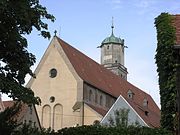
A canopied tower at St Martin's Church, Memmingen

A canopy from Kraków, Poland.
A canopy is an overhead roof or else a structure over which a fabric or metal covering is attached, able to provide shade or shelter. A canopy can also be a tent, generally without a floor.
The word comes from the Ancient Greek κωνώπειον = "cover to keep insects off", from κώνωψ = "cone-face", which is a bahuvrihi compound meaning "mosquito". The first 'o' changing into 'a' may be due to influence from the place name Canopus, Egypt thought of as a place of luxuries.
Architectural canopies include projections giving protection from the weather, or merely decoration. Such canopies are supported by the building to which they are attached and often also by a ground mounting provided by not less than two stanchions, or upright support posts.
Canopies can also stand alone, such as a fabric covered gazebo or Cabana. Fabric canopies can meet various design needs. Many modern fabrics are long-lasting, bright, easily cleaned, strong and flame-retardant. Modern frame materials offer high strength-to-weight ratios and corrosion resistance. The proper combination of these properties can result in safe, strong, economical and attractive products.
Fabric structures offer many advantages over traditional buildings. They can be relocated, erected on any surface, ready in weeks, use natural light, usually do not require permits, and are easily installed.
Reference[]
See also[]
- Chuppah
- Pop up canopies
- Dome
- Onion dome
External links[]
| Wikimedia Commons has media related to Canopies that may be added |
| This page uses Creative Commons CC-BY-SA licensed content from Canopy (building) on Wikipedia (view authors). |